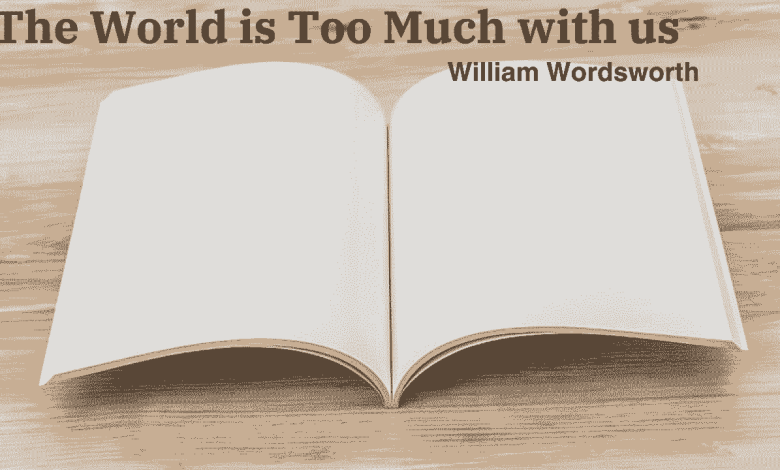
The World is Too Much with Us by William Wordsworth is a poignant sonnet that explores the poet’s disillusionment with the materialistic world and his yearning for a deeper connection with nature.
In The World is Too Much with Us Analysis, we will delve into a critical analysis of the poem, examining its themes, literary devices, and underlying messages.
By understanding the nuances of Wordsworth’s work, literature students can gain valuable insights into the poet’s perspective and hone their analytical skills for exams and literary discussions.
William Blake’s Poem, A Poison Tree Analysis (Vital Themes)
The World is Too Much With Us Summary
In this Petrarchan sonnet, Wordsworth utilizes a structured rhyme scheme and rhythmic meter to convey his sentiments effectively.
The poem begins with a lamentation on humanity’s estrangement from nature, as the speaker bemoans,
“The world is too much with us; late and soon” (line 1).
Through this opening line, Wordsworth immediately sets the tone for the poem, expressing a sense of regret and resignation over the pervasive influence of materialism and consumerism in modern society.
The phrase “late and soon” underscores the ubiquitous nature of this disconnect, suggesting that it is a pervasive condition that affects people at all times and in all places.
In the subsequent lines, Wordsworth contrasts the artificiality of human civilization with the timeless beauty and power of the natural world.
He personifies nature, describing it as a living entity that possesses a wisdom and vitality far beyond human comprehension.
The image of the sea, “Upgathered now like sleeping flowers” (line 5), evokes a sense of awe and wonder at the majesty of the natural world, highlighting its capacity to inspire awe and transcendence.
As the poem progresses, Wordsworth expresses his desire to return to a simpler way of life, one that is in harmony with nature and its rhythms.
He laments humanity’s preoccupation with material wealth and possessions, which he views as distractions that prevent us from experiencing the true beauty and significance of the world around us.
Through vivid imagery and poignant language, Wordsworth urges readers to reevaluate their priorities and rekindle their connection with the natural world, before it is too late.
In the final lines of the poem, Wordsworth expresses a sense of resignation and acceptance, acknowledging that the world may never change and that humanity may continue to be estranged from nature.
However, even in the face of this bleak reality, the poet finds solace in the knowledge that he has chosen a different path, one that leads him back to the simplicity and authenticity of nature.
Overall, “The World is Too Much with Us” is a powerful meditation on the human condition and our relationship with the natural world.
Through its evocative imagery and poignant language, Wordsworth challenges readers to reconsider their values and priorities, urging them to reconnect with the timeless beauty and wisdom of nature.
London by William Blake Analysis and Summary (18th Century)
The World is Too Much with Us Analysis (Themes and Literary Devices)

Here is a complete The World is Too Much with Us Analysis with textual references highlighting important aspects of Romantic and Victorian Poetry.
Let’s begin with the Themes of The World is Too Much with Us.
Nature as a Source of Spiritual Renewal:
In “The World is Too Much with Us,” Wordsworth elevates nature to a sacred status, portraying it as a source of spiritual renewal and solace amidst the chaos of modern life.
The poet expresses a deep yearning to return to a more primal, nature-centered spirituality, free from the confines of organized religion.
This theme of The World is Too Much with Us is encapsulated in the lines, “Great God! I’d rather be / A Pagan suckled in a creed outworn” (lines 9-10), where Wordsworth expresses a preference for the simplicity and authenticity of pagan beliefs over the dogma of established faiths.
Through this imagery, Wordsworth suggests that true spiritual fulfillment can only be found by reconnecting with the natural world and embracing its inherent divinity.
Act wise Macbeth Summary By William Shakespeare
Human Alienation from the Natural World:
Throughout the poem, Wordsworth laments humanity’s estrangement from the natural world, emphasizing our diminished capacity to appreciate its beauty and significance.
The line, “Little we see in Nature that is ours” (line 2), underscores the profound disconnect between humans and their environment, highlighting the extent to which modern society has alienated itself from the rhythms and cycles of nature.
This theme of alienation serves as a poignant reminder of the consequences of our relentless pursuit of progress and material wealth, which often comes at the expense of our connection to the natural world.
Critique of Materialism and Consumerism:
One of the central themes of “The World is Too Much with Us” is Wordsworth’s critique of the shallow materialism and consumerism that characterize modern society.
The line, “For this, for everything, we are out of tune” (line 8), encapsulates the poet’s sense of disillusionment with the materialistic pursuits that dominate human existence.
Wordsworth suggests that our relentless pursuit of wealth and possessions has distanced us from nature and spiritual fulfillment, leaving us out of harmony with the natural world.
Through this critique, Wordsworth encourages readers to reevaluate their priorities and consider the true value of material wealth in relation to the deeper, more enduring riches of the natural world.
3 Critical Analysis Essay Examples (Literary Analysis)
Literary Devices in The World is Too Much with Us
Imagery:
Wordsworth employs vivid imagery throughout the poem to evoke the beauty of nature and the starkness of human civilization.
The image of the sea, “Upgathered now like sleeping flowers” (line 5), conjures a sense of tranquility and majesty, contrasting sharply with the artificiality and busyness of human life.
Through this imagery, Wordsworth invites readers to contemplate the timeless power and beauty of the natural world, highlighting its capacity to inspire awe and wonder.
Personification:
Throughout “The World is Too Much with Us,” Wordsworth personifies nature, portraying it as a living entity with its own voice and agency.
The line, “The winds that will be howling at all hours” (line 6), imbues the natural elements with a sense of vitality and autonomy, emphasizing their independence from human control.
This personification serves to underscore the poet’s reverence for nature and its intrinsic value, highlighting the ways in which it transcends human understanding and manipulation.
Symbolism:
The sea serves as a powerful symbol in “The World is Too Much with Us,” representing the untamed power and majesty of nature.
The line, “The sea that bares her bosom to the moon” (line 4), evokes a sense of awe and reverence for the vastness and unpredictability of the ocean.
As a symbol, the sea contrasts sharply with the artificiality and transience of human constructs, serving as a reminder of the enduring power and beauty of the natural world.
Through this symbolism, Wordsworth emphasizes the importance of reconnecting with nature and acknowledging its significance in our lives.
Circe Goddess in Homer’s Odyssey (The Legendary Witch)
Alliteration and Assonance
Wordsworth employs alliteration and assonance throughout the poem to enhance its musicality and create rhythmic patterns.
The repetition of consonant and vowel sounds, such as in the line, “The winds that will be howling at all hours” (line 6), adds a lyrical quality to the verse, drawing readers into the poet’s contemplative mood.
Through these sonic devices, Wordsworth captures the ebb and flow of natural forces, inviting readers to immerse themselves in the sensory experience of the poem.
Learn How to Write a Critical Analysis in Literature
Conclusion
“The World is Too Much with Us” by William Wordsworth is a timeless meditation on the human condition and our relationship with the natural world.
Through vivid imagery and poignant language, Wordsworth highlights the detrimental effects of materialism and the importance of reconnecting with nature for spiritual renewal.
By critically analyzing the themes, literary devices, and underlying messages of the poem, literature students can gain a deeper understanding of Wordsworth’s perspective and develop valuable insights into the human experience.



